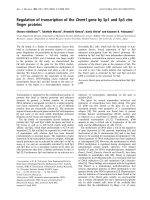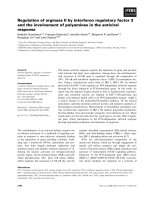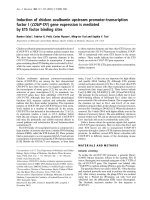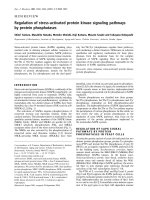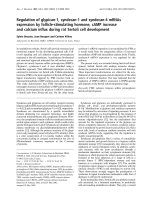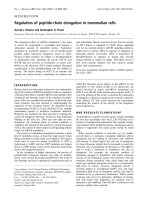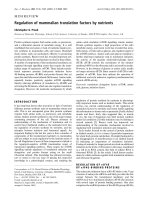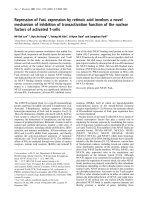Báo cáo y học: " Regulation of cardiac microRNAs by serum response factor" potx
Bạn đang xem bản rút gọn của tài liệu. Xem và tải ngay bản đầy đủ của tài liệu tại đây (866.15 KB, 13 trang )
RESEARCH Open Access
Regulation of cardiac microRNAs by serum
response factor
Xiaomin Zhang, Gohar Azhar, Scott A Helms, Jeanne Y Wei
*
Abstract
Serum response factor (SRF) regulates certain microRNAs that play a role in cardiac and skeletal muscle
development. However, the role of SRF in the regulation of microRNA expression and microRNA biogenesis in
cardiac hypertrophy has not been well established. In this report, we employed two distinct transgenic mouse
models to study the impact of SRF on cardiac microRNA expression and microRNA biogenesis. Cardiac-specific
overexpression of SRF (SRF-Tg) led to altered expression of a number of microRNAs. Interestingly, downregulation
of miR-1, miR-133a and upregulation of miR-21 occurred by 7 days of age in these mice, long before the onset of
cardiac hypertrophy, suggesting that SRF overexpression impacted the expression of microRNAs which contribute
to cardiac hypertrophy. Reducing cardiac SRF level using the antisense-SRF transgenic approach (Anti-SRF-Tg)
resulted in the expression of miR-1, miR-1 33a and miR-21 in the opposite direction. Furthermore, we observed that
SRF regulates microRNA biogenesis, specifically the transcription of pri-microRNA, thereby affecting the mature
microRNA level. The mir-21 promoter sequence is conserved among mouse, rat and hu man; one SRF binding site
was found to be in the mir-21 proximal promoter region of all three species. The mir-21 gene is regulated by SRF
and its cofactors, including myocardin and p49/Strap. Our study demonstrates that the downregulation of miR-1,
miR-133a, and upregulation of miR-21 can be reversed by one single upstream regulator, SRF . These results may
help to develop novel therapeutic interventions targeting microRNA biogenesis.
Background
MicroRNAs (miRNAs) are short (20 to 23-nucleotide),
endogenous, single-stranded RNA molecules that regu-
late gene expression by hybridization to messenger
RNAs (mRNAs) with the consequence of mRNA degra-
dation or translational inhibition of targeted transcripts.
Genes that encode for miRNA are transcribed by either
RNA polymerase II or RNA polymera se III into primary
miRNA (pri-miRNA) transcripts, which are then cleaved
by the nuclear microprocessor complex formed by the
RNase III enzyme Drosha (RNASEN) and the DGCR8
(DiGeorge critical region 8) protein. The RNase III
Dicer cleaves off the loop of the pre-miRNA to generat e
a roughly 22-nucleotide miRNA duplex [1].
Although insights into the regulatory function of miR-
NAs toward their mRNA targets are beginning to
emerge, less is known about the regulation of miRNA
gene expression and miRNA biogenesis [1]. For instance,
it has been shown that miRNAs participate in the control
of cardiac devel opmen t, and a number of miRNAs play a
role in cardiac hypertrophy [2-5]. In addition, serum
response factor (SRF), an important transcript io n factor,
participates in the regulation of several cardiac enriched
miRNAs, including mir-1 and mir-133a [4,6]. However, it
is unclear at what specific stage SRF regulates the biogen-
esis of miRNA.
SRF is a member of the MADS (MCM1, agamous,
deficiens, SRF) family of transcriptional activators that
has been implicated in the regulation of a number of
genes that are important in cell proliferation and differ-
entiation. SRF regulates its target genes by binding to
the serum response element (SRE), which contains a
consensus CC(A/T
6
)GG (CArG) motif [7-9]. This cog-
nate response site of SRF is found in the promoter
region of certain immed iate-early genes and many mus-
cle-specific genes [9-11]. Two CArG-like elements have
been found in the promoter of mir-1-1 and mir-1-2
genes [4]. The level of SRF expression apparently
changes during development and adult aging [12].
Therefore, it is plausible that SRF may impact not only
* Correspondence:
Donald W. Reynolds Department of Geriatrics, The University of Arkansas for
Medical Sciences and Geriatric Research, Education and Clinical Center,
Central Arkansas Veterans Healthcare System, Little Rock, AR 72205, USA
Zhang et al. Journal of Biomedical Science 2011, 18:15
/>© 2011 Zhang et al; licensee BioMed Central Ltd. This is an Open Access article distribut ed under the terms of the Creative Commons
Attribu tion License ( which permits unrestri cted use, distribution, and reproduction in
any medium, provided the original work is properly cited.
cardiac muscle gen es but also certain miRNA gen es
throughout one’s lifespan.
In the present study, we utilized SRF transgenic
mouse models t o study the impact of serum response
factor (SRF) on cardiac miRNA expression, and miRNA
biogenesis. We observed that approximately 1/10 of the
recently identified 578 miRNAs are highly expressed in
the mouse heart; SRF overexpression in the mouse heart
resulted in altered expression of a number of miRNAs,
including the down-regu lation of mir-1 and mir-133a,
and up-regulation of mir-21, which are usually dysregu-
lated in cardiac hypertrophy and congestive heart failure
[3,13-16]. When the mouse cardiac SRF level was
reduced using the antisense-SRF transgenic approach,
we observed an increase in expression of miR-1 and
miR-133a miRNA, and a decrease in expression of miR-
21. In addition, we observed that SRF executes its regu-
latory role on miRNA expression through controlling
the transcription of the pri-miRNA, the first step of
miRNA biogenesis. Our findings demonstrate for the
first time that it is possible to regulate at the same time
the expression of three miRNAs, miR-1, miR-133a and
miR-21, through targeting the components of SRF-
mediated signaling pathway.
Materials and methods
Two transgenic mouse models
Thewild-typeFVBmiceandthetransgenicmiceon
FVB background ranged from age at 7 days to 6
months. To study the effect of SRF level on cardiac
gene expression and function in the mouse heart, we
employed the cardiac-specific transgenic approach to
incr ease the SRF protein level in o ne mouse model, and
to reduce it in another mouse model. Figure 1A sho ws
that in SRF overexpression transgenic mice (SRF-Tg),
the a-MHC promoter drives the expression of a full-
length SRF cDNA, which causes the cardiac-specific ele-
vation of SRF by approximately 40%; the cardiac pheno-
type of this model has been previously reported [12].
Figure 1B shows that in antisense-SRF transgenic mice
(Anti-SRF-Tg), the a-MHC promoter drives the expres-
sion of the full-length SRF cDNA in the antisense orien-
tation. The transgenic overexpression of antisense-SRF
RNA sequence interferes with the endogenous SRF
mRNA and consequently reduces SRF protein level in
the mouse heart (Figure 1C)[17]. The mRNA expression
levels of 6 cardiac genes were shown in Figure 1D.
After euthanasia, the hearts were removed from mice
and subjected to standard RNA isolation and histologi-
cal procedures. For each time point, there were three
independent biologic al replicates. The studies were con-
ducted with Institutional Review Board approval and in
accordance with the NIH Guiding Principles for
Research Involving Animals.
Total RNA isolation
All RNA samples were first isolated from the mouse
cardiac ventricles using UltraSpec RNA Isolation
Reagent as previously described [12]. To clean mouse
DNA contaminatio n and enrich the small RNA fraction,
the total RNA samples were purified using miRNeasy
Min i kit (Qiagen ) and RNase-free DNase I according to
the manufacture’s instruction manual.
Northern Blotting and Western Blotting
The Northern blotting was carried out as previously
described [18,19]. Briefly, a
32
P-labelled double-stranded
SRF cDNA fragment from plasmid pCGNSRF was used
as the probe for the detection of SRF mRNA in wild
type mouse and SRF-Tg heart, as well as the antisense-
SRF transcripts in Anti-SRF-Tg heart, respectively.
The ANF, b-MHC, cardiac actin, MLC2v and SERCA2
transcripts were detected by
32
P-labeled oligonucleo-
tides. The sequences of the oligonucleotide probes
were as follows: ANF, 5’ -ccggaagctgttgcagcctagtc-
cactctgggctc caatcctgtcaatcctacccccgaagcagctgga-3’ ;
b-MHC: 5’-gagggcttcacgggcaccct tagagctgggtagcacaagatc-
tactcctcatt caggcc-3’. Ventricular myosin light chain-2
(MLC2v) isoform: 5’-cacagccctgggatggagagtgggctgtgggt-
cacct gaggctgtggttcag-3’ . Cardiac a-actin: 5’ -agggggctca-
gag gattccaagaagcacaatacggtcatcctgaatataaggtaggctaa-3’;
sarcoplasmic reticulum Ca
2+
-ATPase (SERCA2), 5’-tcagt
catgcagagggctggtagatgtgttgctaacaacgcacatgcacgcaccc
gaaca-3’.
The Western blotting was performed as previously
described [18,19]. Briefly, 50 ug of protein was separated
by SDS-PAGE on a polyacrylamide gel and transferred
to nitrocellulose. The membrane was blocked for 2 h at
room temperature in 5% nonfat milk in Tris 20 mM,
sodium chloride 137 mM, 0.1% Tween-20, pH 7.6 (TBS-
T) and the n incubated for 2 h at room temperature
with SRF antibody followed by incubation for 1 h with
horseradish peroxidase conjugated secondary antibody.
Immunoreactive bands were visualized by chemilumi-
nescence (ECL, Amersham International). The antibo-
dies were purchased fro mSigma,andSantaCruz
Biotechnology.
MicroRNA arrays
The ventricular tissue samples used for the microRNA
array analysis were obtained from 6-month-old wild-
type mice and age-matched SRF-Tg mice. The RNA
sample isolation and microRNA array were performed
in triplets for both wild-type and transgenic mice.
A total of 6 RNA samples of ventricular tissue were
shipped on dry ice to Exiqon, Inc., which provided the
service for RNA quality verification and microRNA
array hybridization as well as comprehensive statistical
analysis. The microarray data have been deposited in
Zhang et al. Journal of Biomedical Science 2011, 18:15
/>Page 2 of 13
the NCBI Gene Expression Omnibus (GEO) database
( under accession no.
GSE23044. Briefly, each pair of wild-type and transgenic
heart samples were labeled with Hy 3 and Hy5 fluores-
cent dyes respectively and hybridized to a miRCURY
LNA™ mouse microRNA Array (version 10.0), which
held 578 mature microRNA probes, as well as perfectly
matched and mismatched probes for quality control.
After signal amplification, the background was sub-
tracted and normalized using LOWESS (Locally
Weighted Scatter plot Smoothing) regression algorithm.
Thi s within-slide normalization was performed to mini-
mize differences between the colors in an intensity-
dependent manner. The array output was received in
Excel spreadsheets containing the normalized micro-
RNA expression profiles in each heart sample, the
expression comparison between transgenic versus wild-
type heart samples and “Expression Matrix” containing
normalized Hy3/Hy5 ratios (log2 transformed) from all
hybridizations. The list was sorted based on the most
variant expressed miRNAs comparing the two sample
types. 20 of 578 miRNA passed the filtering criteria with
average “log-Median-Ratio” >0.50, which represents at
least >1-fold change in microRNA expression.
Real-time PCR quantitation of pri-miRNAs and mature
RNAs
Detection of pri-miRNAs
The primers for the detection of pri-miRNAs were
designed using PRISM Primer Express 3.0 software
(Applied Biosystems), and synthesized at Integrated
DNA Technologies Inc. The first-strand cDNA synthesis
was carried out using rando m hexamer prime r, and the
PCR was performed using the following primers: pri-
mir-1-1 forward: 5’-ccaagtgtgcatgtgtgagag-3’, pri-mir-1-1
reverse: 5’-atgtctgacgagcacttccac-3’. pri-mir-1-2 forward:
5’ -accacaagcagaagtggcatt-3’ , pri-mir-1-2 reverse:
5’-tggaagtcatcc tcctggaaa-3’.pri-mir-21forward:5’-ccaga-
gatgtttgctttgctt-3’, pri-mir-21 reverse: 5’-tgccatgagattcaa-
cagtca-3’ . pri-mir-133a1 forward 5’-cactgatgtgagctgca
agaa-3’, pri-mir-133a1 reverse 5’-tccaaataaggttgacagttgct-
3’. pri-mir-133a2 forward 5’ -caagaactgcttttccccttc-3, pri-
mir-133a2 reverse 5’-tttcttggatctgaccattgc-3’. pri-mir199a1
forward 5’-ctgaggaactgaacagccatc-3’, pri-mir199a1 reverse:
Figure 1 Two models of transgenic mice. 1A and 1B: Scheme of DNA constructs for the generation of two distinct transgenic mouse models,
in which the a-MHC-Promoter (a-MHC-Pr.) drives the transgene expression in the postnatal heart. 1A. DNA construct for the generation of
cardiac-specific overexpression of SRF transgenic (SRF-Tg) mice. 1B. DNA construct for the generation of cardiac-specific antisense-SRF transgenic
(Anti-SRF-Tg) mice. 1C. Western blot revealed increased SRF protein in SRF-Tg versus wild-type (WT) mice, and decreased SRF protein level in
Anti-SRF-Tg versus WT mice. 1D. Northern blot analysis of cardiac gene expression in wild-type (WT) versus SRF-Tg, as well as WT versus Anti-
SRF-Tg (Anti-SRF) mice. The SRF transcript (SRF*) was detected by a
32
P-labelled double-strand SRF cDNA fragment, which hybridizes with both
sense-SRF transcript and antisense-SRF transcript, respectively. The probes for ANF, b-MHC, cardiac actin, MLC2v and SERCA2 are
32
P-labeled
oligonucleotides.
Zhang et al. Journal of Biomedical Science 2011, 18:15
/>Page 3 of 13
5’-gtctggaagttcccactgttg-3’. pri-mir381 forward: 5’-tggtact-
taaagcgaggttgc-3’, pri-mir381 reverse: 5’-ggtcatgcacacaca-
taccac-3’. pri-mir499 forward: 5’-gcatgtgaacatcacagcaag-3’,
pri-mir499 reverse: 5’-ccaaacaccacctaagtcttc-3’.
Detection of other genes
Myocardin, forward primer 5’-ccaatcaattcccaggaaagc-3’
and reverse primer 5’-tgggaccatttgggagtcaa-3. Zipzap,
forward primer 5’-tctt gactgaactctggcactca-3’ and revers e
primer 5’-ctctgttctgtggccttggaa-3’.P49/Strap,forward
primer: 5’-agaagtgaagcgaatccgagtt- 3 and reverse primer
5’ -gtctgccgacactcctgaca-3’ . Atrial natriuretic factor
(ANF) forward primer 5’ -tgggacccctccgatagatc and
reverse primer 5’-agcgagcagagccctcagt-3’.
The U5G small nuclear RNA (U5G) gene was used as
an internal control: U5G forward: 5’-aaagatt tccgtg gagag-
gaa-3’ , U5G reverse: 5’ -ccaagacaaggcctcaaaaa-3’.The
PCR amplification was performed in a 7900HT Fast
Sequence Detector System (Applied Biosystems) with
following program: Cycle 1, 95°C for 10 minutes. Cycle
2, 40 cycles of 95°C for 15 seconds, 60°C for 60 seconds.
Cycle 3, 95°C for 15 seconds, 60°C for 15 seconds, 95°C
for 15 seconds. CT values were automatically obtaine d.
Relative expression values were obta ined by normalizing
CT values of the miRNA genes in comparison with CT
values of the U5G gene, using the CT method [20,21].
Detection of mature miRNAs
To detect each mature miRNA, the first-strand cDNA
synthesis was carried out with a miRNA-specific primer,
and then PCR was carried out with a miRNA-specific
LNA-PCR primer a nd a universal PCR primer. The pri-
mers for miR-1, miR-21, miR-13 3a, miR-199a, miR-381
and miR-499-5p, 5S RNA reference primers, t he cDNA
synthesis kit and real-time PCR reagents were obtained
from Exiqon Inc. The PCR amplification was performed
under the conditions as mentioned above.
Plasmid constructs
The mmu-mir-21 gene was amplified with forward pri-
mer 5’-aatggatccaaacagctttctttcctagaattgg-3’ and reverse
primer 5’-aa gtctcacaagacataaggaccacaagctt tta-3’ with
PCR. The PCR fragment was then ligated into BamHI
and HindIII digested pSilencer 4.1 vector. A DNA fra g-
ment containing mmu-mir-21 proximal promoter region
(-3 bp to -589 bp) was amplified with forward primer 5’-
tactcgagtaaagggtacaggaagtaagggt-3’ and reverse primer
5’ -atcaagctt ttctgagaagtcccacatttat-3’, and subsequently
cloned into pGL3 vector. All the DNA constructs were
confirmed by sequencing analysis. Other plasmid con-
structs that were used in the study have been previously
described, which inclu de pGL3-ANF promoter vector,
pGL3-cardiac actin promoter vector, pAdTrack-CMV,
pAd-CMV-wtSRF, pcDNA3-49/Strap, pcDNA3-Zipzap,
pcDNA3-SRF-delta-3 Nkx2.5 and GATA-4 [12,19,22,23].
The wild-type myocardin plasmid is a generous gift of
Dr. E. Olson [24].
Transfection Assays
Transient transfections were carried out with the Lipo-
fectamine 2000 reagen ts (Inviroge n) as previousl y
described [22,25]. At 4 h after the transfection was
initiated, the NIH3T3 cells were pl aced in Dulbecco’ s
modified Eagle’s medium with 10% fetal calf serum and
incubated overnight. The cells were then cultured in
Dulbecco’s modified Eagle’s medium with 0.1% fetal calf
serum for another 24 h and then placed i n Dulbecco’s
modified Eagle’s medium with 20% fetal calf serum for
an additional 3.5 h. Firefly luciferase activity was mea-
sured as relative light units. To control for variability,
the number of relative light units from individual trans-
fection experiments was n ormalized by measuring
Renilla luciferase activity expressed from a cytomegalo-
virus promoter-driven vector in the same samples. Indi-
vidual transfection experiments w ere carried out in
triplicate, and the results were reported as mean firefly
luciferase/Renilla luciferase activity (mean ± S.D.) from
representative experiments.
Statistical analysis
Data are given as mean values ± SD, with n denoting
the number of experiments unless otherwise indicated.
A list of differentially expressed microRNAs were identi-
fied using a t-test with a combination of cut off p-value
(p < 0.05) and at least 1-fold change.
Results
1. The microRNA expression in wild-type mouse hearts
To get an overview o f microRNA expression in the
mouse heart, the Exiqon microRNA array that detects
578 microRNAs was employed for the microarray anal y-
sis. The signal intensity of miRNAs in the wild-type
mouse ranged from a low of 40 to a high of 47,243,
with approximately 50 miRNAs having signal density
above 2000 (Figure 2A). In terms of signal intensity,
these 50 microRNAs accounted for approximately 80%
of all the combined microRNAs expressed in the heart
(Figure 2B and Table 1), indicating that they are
cardiac-enriched miRNAs. When compared with
U6-snRNA gene, which is a gene that was used as a
reference, approximately 35 miRNAs were expressed
higher than that of U6-snRNA genes (Figure 2C). The
miR-1 was ranked number one in the level of expression
among all the microRNAs detected, and it alone
accounted for 7% of all the microRNA expression sig-
nals, and 9% of the 50 cardiac-enriched microRNA sig-
nals. Another important miRNA, mir-133a, was ranked
number seven in terms of level of expression.
Zhang et al. Journal of Biomedical Science 2011, 18:15
/>Page 4 of 13
AlthoughthemajorityofthemiRNAsaretranscribed
from a single gene, some miRNAs are transcribed from
more than one gene. For examples, the mature miR-1 is
processed from pri-mir-1-1 and pri-mir-1-2 transcripts
that are transcribed from two genes, mir-1-1 (on chromo-
some 2) and mir-1-2 (on chromosome 18), respectively.
Bioinformatics analysis reve aled that the 5-kb promoter
sequence of these two genes was divergent, and that each
gene promoter contains a different number of CArG-like
sequences. To test the hypothesis that mir-1-1 and mir-1-
2 genes may have different transcriptional activity, the
pri-mir-1-1 and pri-mir-1-2 transcript level were
measured with real-time RT-PCR. As shown in Figure 2D,
pri-mir-1-1 level was 6-fold higher than that of pri-mir-1-
2 (n = 3, p < 0.05). Simila rly, the mature miR-133a is
derived from both mir-133a1 gene (on chromosome 18)
and mir-133a2 gene (on chromosome 2). Real-time RT-
PCR showed that pri-mir-133a1 level was 2-fold lower
than that of pri-mir-133a2 (n = 3, p < 0.05) (Figure 2D).
These data suggest that the contribution of each pri-
miRNA to the mature miRNA pool may be different.
2. Cardiac SRF level affects the expression of microRNAs
in the mouse heart
SRF is known to regula te mir-1, which regulates certain
critical cardiac regulatory proteins that control the
Figure 2 The expression of microRNA in wild-type mouse heart. 2A. Approximately 50 microRNAs are cardiac-enriched microRNAs that are
highly expressed in the adult mouse heart. 2B. The 50 cardiac-enriched microRNAs account for approximately 80% of the total microRNA
expression in the mouse heart, whereas the remaining 528 miRNAs account for only 20% of the total microRNA expression. 2C. The expression
levels of 50 cardiac-enriched microRNAs and U6-snRNA (reference gene). miR-1 ranks number 1 in expression, miR-133a ranks number 7 in
expression. The expression level of miR-499 is similar to that of U6-snRNA. 2D. Differential expression of pri-miRNA transcripts. Both pri-mir-1-1
and pri-mir-1-2 are processed into mature miR-1, but pri-mir-1-1 transcript level is 6-fold higher than that of pri-mir-1-2 (n = 3, p < 0.05*). The
pri-mir-133a1 level is lower than that of pri-mir-133a2 (n = 3, p < 0.05*). These data suggest that the contribution of each pri-miRNA to the
mature miRNA pool may be different.
Table 1 The 50 cardiac-enriched microRNAs that are
expressed in the wild-type adult mouse heart
miR-1 miR-26b miR-24 miR-144 let-7b
let-7f miR-30a miR-23a miR-27a miR-30d
miR-133b miR-23b miR-26a miR-30e miR-130a
miR-451 miR-29a miR-16 miR-302d* miR-923
miR-126 miR-30c let-7d miR-805 miR-15a
miR-22 miR-125b-5p miR-690 miR-499 miR-486
miR-133a let-7c miR-709 miR-27b miR-195
miR-30b miR-143 let-7a miR-29c miR-101a
miR-208a let-7g let-7e let-7i miR-142-3p
miR-720 miR-378 miR-29b let-7i miR-126-5p
Zhang et al. Journal of Biomedical Science 2011, 18:15
/>Page 5 of 13
balance between differentiation and proliferation during
cardiogenesis [4]. To identify other miRNAs that may
be regulated by SRF, we examined the expression of car-
diac miRNAs in response to SRF overexpression in the
mouse heart. As shown in Figure 3A, SRF overexpres-
sion changed the expression of cardiac-enriched micro-
RNAs to different extents.
Twenty microRNAs were significantly up or down-
regulated by at least 1-fold in SRF-Tg versus wild-type
mice (Figure 3B). Real-time RT-PCR analysis of 6
microRNAs confirmed the microRNA array data
(Figure 4A).
We had previously observed that mild-overexpression
of SRF resulted in the onset of cardiac hypertrophy at
6 months of age [12]. To define whether altered expres-
sion of microRNA might be the result of SRF overex-
pression, or a secondary effect caused by cardiac
hypertrophy in the SRF-Tg heart, we determined
miRNA expression at the ages of 7 days, 2 months and
4 months, and after the onset of the hypertrophic
phenotype, at around 6 month of age. As shown in
Figure 4B, altered expression of miRNA occurred at as
early as 7 days after birth, long before the onset of car-
diac hypertrophy and co ntinued through 6 mo nths of
age, suggesting that SRF overexpression is likely the
main factor contributing to dysregulation of microRNAs.
To test the hypothesis that a mild reduction of cardiac
SRF level may result in the expression of microRNAs in
the opposite direction to that which was observed in the
SRF-Tg, we employed Anti-SRF-Tg, in which SRF pro-
tein expression was mildly decreased in the heart
(Figure 1C). Reduced SRF protein in the heart resulted
in decreased expression of ANF, increased expression
of cardiac a-actin, MLC2v and SERCA2 expression
(Figure 1D); it also resulted in impr oved cardiac perfor-
mance in response to stress [17].
Real-time RT-PCR analysis revealed that mildly
reduced SRF resulted in the down-regulation o f miR-21
expression, but up-regulation of both miR-1 and miR-
133a (Figure 5A). These results were in the opposite
direction compared with that which was observed with
mild SRF overexpression in the SRF-Tg heart.
We further tested the expression of three SRF cofac-
tors, namely myocardin, p49/Strap and Zipzap in these
two mouse models, and used ANF as a reference. As
shown in Figure 5B, increased expres sion of myocardin,
Zipzap and ANF was observed in SRF-Tg, while
decreased expression of myocardin, Zipzap and ANF
was observed in Anti-SRF transgenic mouse heart com-
pared to their age-matched wild type mice, respectively
(p < 0.05, n = 3). There was no significant change in the
expression of p49/Strap in SRF-Tg versus w ild-type
heart (NS, n = 3), but p49/Strap was decreased in the
anti-SRF-Tg versus wild-type heart (p < 0.01, n = 3).
3. SRF regulates the transcription of pri-miRNA transcript
The transcription of pri-miRNA is the first step in
miRNA biogenesis [26]. Pri-miRNA is then cleaved into
pre-miRNA before maturity [27]. To define whether
increased SRF protein in the heart could affect pri-
miRNA transcription, the pri-miRNA expression level in
SRF-transgenic mouse heart was compared with that in
the wild-type. Interestingly, all the pri-miRNAs exam-
ined were altered in SRF-Tg compared to wild-type
mouse, suggesting that SRF affects pri-miRNA transcrip-
tion (Figure 6).
To determine whether pri-miRNA level correlates
with mature miRNA level, the pri-miRNA levels were
compared with that of their corresponding mature
forms (miR). As shown in Figure 6, when pri-mir-1-1
and pri-mir-1-2 tra nscripts were down-regulated, so was
miR-1 mature form; when pri-mir-133a1 and pri-mir-
133a2 transcripts were down-regulated, the same was
true for miR-133a mature form. Similarly, when pri-mir-
21, pri-mir-199a, and pri-mir-381 primary t ranscripts
were up-regulated, their mature miRNA forms were up-
regulated as well (Figure 6). These data suggest that SRF
regulates pri-miRNA expression, thereby affecting the
mature miRNA level.
4. SRF regulates mir-21 expression
MiR-21 was increased in SRF-Tg heart (Figure 4A, B,
5A) compared to wild-t ype mice. However, miR-21 was
decreased i n Anti-SRF-Tg heart compared to that of the
wild-type mouse heart (Figure 5A), indicating that
miR-21 expression is regulated by the SRF protein. To
evaluate the mir-21 gene promoter region, the DNA
sequences of mouse, rat and human mir-21 genes and
flanking regions were obtained from Genbank database.
The mir-21 pri-miRNA sequence was obtained from
GenBank sequence AY699265 and also from the
sequence reported by Fujita et al. [28].
Analysis of the mir-21 promoter region revealed that
the mir-21 gene has a classic SRF binding site or CArG
element that is composed of “CCTAATAAGG”,which
is found to be 197 bp upstream of the pri-mir-21 tran-
script start p oint (Figure 7A and 7B). The human, rat
and mouse mir-21 promoter region is relatively con-
served, as is the classic SRF binding site (Figure 7A).
To test whether the mir-21 promoter would respond to
the regulation of SRF and SRF cofactors in vitro, a mir-21
promoter-luciferase construct was generated, which contains
a 0.58 kb DNA fragment of mir-21 promoter (Figure 7B).
Transfection assay using SRF, p49/Strap and myocardin was
performed.AsshowninFigure8A,themir-21genepromo-
ter was repressed by SRF and p49/Strap alone. The mir-21
promoter was strongly activated by myocardin, but the acti-
vation induced by myocardin was repressed b y p49/Strap at
various concentrations (Figure 8A).
Zhang et al. Journal of Biomedical Science 2011, 18:15
/>Page 6 of 13
To examine the effect of increased miR-21 microRNA
level on cardiac gene expression, a mir-21 expression
vector containing mir-21 DNA sequence was generated
using pSilencer4.1 vector. The pSilencer4.1-mir-21
expression vector was cotransfected with ANF promoter
and cardiac actin promoter plasmid vectors, respectively.
As shown in Figures 8B and Figure 9, miR-21 expres-
sion upregulated ANF promoter activity, while it
repressed cardiac actin expression. The SRF cofactors
p49/Strap, Zipzap, Nkx2.5, GATA-4 had modulatory
effects on both ANF and cardiac actin expression
(Figures 8B and 9).
Discussion
The prese nt study has several f indings. We observed a
broad range of miRNAs that are expressed in the wild-type
Figure 3 The impact of SRF overexpression on the expression of cardiac miRNAs. 3A. Comparison of the expression of 50 cardiac-enriched
miRNAs in adult SRF-Tg with that in age-matched wild-type mice. 3B. The 20 microRNAs that are found to have at least 1-fold change in the
hearts of adult SRF-Tg mice compared to that of age-matched wild-type (WT) mice. Both guide strand and passenger strand (*) of mir-133a are
decreased in SRF-Tg vs. wild-type mice.
Zhang et al. Journal of Biomedical Science 2011, 18:15
/>Page 7 of 13
mouse heart. Cardiac-specific overexpression of SRF
significantly impacted a number of miRNAs, which
are potential SRF target miRNAs. Future investigation
of these miRNAs may enhance our understanding of
their role in the SRF-mediated regulation of cardiac
development, maturation and aging. Interestingly, we
found that SRF regulates microRNA biogenesis, speci-
fically at the stage of transcription of the pri-miRNA
transcript. The expression levels of miR-1, miR-133a
and miR-21 were observed to be in the opposite
direction with reduced cardiac SRF level in the Anti-
SRF-Tg mouse. Our study reports for the first time a
successful attempt to reverse the expression of these
three miRNAs, which are frequently dysregulated in
cardiac diseases, through targeting their upstream
regulator.
Figure 4 SRF overexpression affected the expression of cardiac miRNAs. 4A. The expression of 6 miRNAs in adult wild-type vs SRF-Tg
hearts was confirmed by real-time PCR. The data showed that the miRNA levels in SRF-Tg were altered significantly compared to that of wild-
type mice (p < 0.05*, n = 3). 4B. Altered expression of microRNAs occurred at as early as 7 days of age, and continued to 6 months of age in
SRF Tg mice. miR-21 was increased in the heart of SRF Tg mice, but both miR-1 and miR-133a were decreased in the heart of SRF Tg mice
compared to age-matched wild-type mice. The down-regulation of miR-1 correlates closely with that of miR-133a in SRF-Tg at various time
points from 7 days to 6 months of age (p < 0.05, n = 3 for all time points, except n = 6 for miR-21 at 6 months).
Figure 5 Reduced SRF protein levels in mouse hearts resulted in gene expression patterns that were opposite to what was observed in
SRF-Tg heart. 5A. The up-regulation of miR-21, and the down-regulation of miR-1 and miR-133a were observed in SRF-Tg compared to wild-type
(WT) mouse heart (P < 0.01**, n = 3). Interestingly, the down-regulation of miR-21, but up-regulation of miR-1 and mir-133a were observed in Anti-
SRF-Tg compared to wild-type mouse heart (p < 0.01**, n = 3). 5B. Myocardin, Zipzap, p49/Strap and ANF were up-regulated in the SRF-Tg
compared with the wild-type mouse heart, but down-regulated in the Anti-SRF-Tg compared with the wild-type mouse heart (p < 0.01**, n = 3).
Zhang et al. Journal of Biomedical Science 2011, 18:15
/>Page 8 of 13
It is known that miRNA expression is altered in a
number of diseases and pathological conditions,
including cardiac hypertrophy and heart failure
[3,13,14,29,30]. The miRNA profile has been shown to
serve as an impressive phenotypic signature. Therefore,
miRNA has the potential to be developed as diagnostic
and/or prognostic tools [31]. On the other hand, since
individual miRNAs are dysregulated either negatively
or positively with disease, strategies are needed to
counteract or reverse the altered expression, potentially
through reconstituting and/or targeting regimens,
respectively [32-34]. A deeper understanding of
miRNA biogenesis, as well as the regulation of each
step in the miRNA maturation process and the
Figure 6 The expression of mature miRNA (miR) and pri-miRNA transcript(s) in adult SRF-Tg compared with that in age-matched wild-
type mice. The expression of miR correlates with its corresponding pri-microRNA transcript(s), indicating SRF regulates pri-microRNA
transcription. The change in expression of the microRNAs between SRF-Tg and wild-type mice was significant (p < 0.05*, or p < 0.01**, n = 3).
Figure 7 The promoter region of the mir-21 gene. 7A. The DNA sequence of mir-21 promoter region was conserved among mouse, rat and
human, and a consensus CArG motif was found in the promoter of all three species. 7B. The mouse mir-21 gene sequence corresponding to
pri-mir-21 and its promoter region. A CArG motif is 197 bp upstream of mir-21 primary transcript. A pGL3-luciferase construct containing
promoter fragment (-586 bp to -3 bp) was generated and used in the present experiment (see details in Materials and Methods).
Zhang et al. Journal of Biomedical Science 2011, 18:15
/>Page 9 of 13
Figure 8 Mir-21 and ANF Promoter activity assays. 8A. Mir-21 promoter is regulated by SRF and its cofactors, myocardin and p49/Strap. In
vitro transfection assay indicates that both SRF and p49/Strap repressed the mir-21-luciferase reporter activity, respectively (p < 0.05, n = 3).
Myocardin (MYOCD) strongly activated the mir-21 promoter activity (p < 0.05). p49 also repressed mir-21-luciferase reporter activity induced by
myocardin in a dose-dependent manner (p < 0.01 **, n = 3). 8B. The mir-21 microRNA up-regulates ANF expression. The microRNA mir-21 up-
regulated ANF gene promoter (p < 0.05*, n = 3). P49/Strap (p49), SRF isoform Δ3, SRF, Zipzap (zip) and Nkx2.5 all down-regulated the ANF gene
promoter activity that was induced by mir-21 microRNA (p < 0.05, n = 3).
Figure 9 The mir-21 microRNA represses cardiac actin expression, but SRF and its cofactors activate cardiac actin expression. The mir-
21 microRNA repressed cardiac actin gene expression compared with control (P < 0.05*, n = 3). Transfection of several other genes up-
regulated the cardiac actin gene compared with mir-21 alone: p49/Strap (p49), Zipzap (Zip), SRF-Δ3 isoform (Δ3), SRF, Nkx2.5, GATA-4,
respectively (P < 0.05*, n = 3).
Zhang et al. Journal of Biomedical Science 2011, 18:15
/>Page 10 of 13
involvement of signaling pathways and transcription
factors is needed.
It has been reported that miRNAs undergo multiple
steps during biogenesis, in which three forms of miR-
NAs are produced: pri-miRNA, pre-miRNA and mature
miRNA [1,35]. Multiple proteins are involved in this
process. RNA polymerase II or RNA polymerase III
transcribes the transcripts of pri-miRNA; a microproces-
sor complex cleaves pri-miRNA to generate pre-miRNA;
and another endonuclease, Dicer, cleaves the pre-
miRNA to release a miRNA-m iRNA duplex. The
miRNA strand is then stripped away from the duplex to
leave a mature, approximately 22-nucleotide miRNA
[36]. These indi vidual steps can be targeted to increase
or decrease the miRNA level. Our data reveal that SRF
executes it regulatory role in miRNA biogenesis through
transcriptional regulation where it controls the amount
of pri-miRNA available for downstream miRNA matura-
tion process. We have proposed a model of miRNA reg-
ulation by SRF and its cofactors (Figure 10).
Mir-21 is known to be up-regulated in many forms of
cancer as well as in the heart during cardiac hyper-
trophic growth and heart failure [37-40]. In the failing
heart, miR-21 levels are increased in fibroblasts where it
inhibits sprouty homologue 1 (Spry1) and promotes
fibrosis [16]. In vivo, the silencing of miR-21 by a speci-
fic “antagomir” in a mouse pressure-overload-induced
disease model was reported to reduce cardiac ERK-MAP
kinase activity, inhibit interstitial fibrosis and attenuate
cardiac dysfunction [16]. It has been reported that TGF-
b and BMP signaling promote a rapid increase in the
expression of mature miR-21 at the post-transcrip tional
level through accelerating the process of pri-miR-21 into
precursor m iR-21 (pre-miR-21) by the DROSHA com-
plex [41]. Mir-21 is one of the miRNAs t hat was signifi-
cantly increased in the SRF-T g heart, but was decreased
in the anti-SRF-Tg heart. However, the mir-21 gene
promoter was repressed by SRF and p49/S trap in trans-
fection assay, and the promoter was strongly induced by
myocardin. Similarly, we observed that SRF activates
both cardiac a-actin and MLC-2v promoter-luciferase
DNA constructs in vitro assay, but SRF repressed the
expression of both mRNA in the mouse heart [18,22].
These data indicate that the regulation of mir-21 gene
expression is complex, and involves SRF in coordination
with multiple SRF cofactors, including myocardin, p49/
Strap and Zipzap. The fact that a “knock-down” of SRF
level could decrease the mir-21 level provides an oppor-
tunity for future studies manipulating m ir-21 level
through the SRF-mediated signaling pathway.
Both miR-1 and miR-133a are produced f rom the
same polycistronic transcripts, which are encoded by
two separate genes in the mouse and the human gen-
omes [42]. The mouse pri-mir-1-1 and pri-mir-133a-2
are transcribed into a polycistronic transcript that is 10
kb in length, and the pri-mir-1-2 and pri-mir-133a-1 are
transcribed into another polycistronic transcript that is
6 kb in length [42]. Our data revealed that the down-
regulation of miR-1 c orrelates closely with that of miR-
133a in the SRF-Tg at various time points from 7 days
to 6 months of age (Figure 7B). These findings suggest
that SRF may regulate these two miRNAs at the level of
polycistronic transcription, rather than at e ach indivi-
dual miRNA (pri-mir-1 or pri-mir-133a) transcription,
Figure 10 A model of miRNA regulation mediated by SRF and its cofactors, including myocardin, p49/Strap, Zipzap and other proteins.
Generally, the pri-miRNA transcript contains one miRNA (e.g pri-mir-21), but it can also contain more than one miRNAs (e.g. mir-1 and mir-133a).
SRF regulates the transcription activity of both types of pri-miRNAs, thereby affecting the downstream mature miRNA level. The length of three
representative primary transcripts: pri-mir-21 is over 3 kb, “pri-mir-1-1 and pri-mir-133a2” is 10 kb, and “pri-mir-1-2 and pri-mir-133a1” is 6 kb.
Zhang et al. Journal of Biomedical Science 2011, 18:15
/>Page 11 of 13
thereby keeping the expression of both miRNAs closely
correl ated. Since mir-1-1 and mir-1-2 genes are located
on two different chromosomes, their expression is diver-
gen t. The pri-mir-1-1 is expressed at 6-fold higher than
pri-mir-1-2. Therefore, the contribution of pri-mir-1-1
to the mature miR-1 pool may be greater than that of
pri-mir-1-2. Given the fact that targeted mutation of
mir-1-2 gene resulted in embryonic myocardial dysfunc-
tion and half of the mutant mice suffered early death
due to ventricular septal defect (VSD) [4], one might
speculate that a targeted mutation of mir-1-1 gene
would also cause equally (or more) severe consequences.
The miR-1 is the most abundant miRNA that is
expressed in the heart. Our present study reveale d that
miR-1 accounted for 7% of all the 578 miRNAs detected
by the microarray. Mir-1 and mir-133a are down-regu-
lated in cardiac hypertrophy and cardiac failure, suggest-
ing that they may play a role in the underlying
pathogenesis [14,43]. It is plausible that increasing mir-1
and mir-133a level at a specific time point ma y have
potentially beneficial effects against the pathological
conditions. Matkovich et al reported that an increase of
mir-133a level in the postnatal heart has beneficial
effects against cardiac fibrosis after transverse aortic
constriction [44].
In conclusion, our current study demonstrates that
cardiac-specific overexpression of SRF leads to altered
expression of cardiac miRNAs, especially the down-reg-
ulation of miR-1 and miR-133a, and up-regulation of
miR-21, the dysregulation of which is known to contri-
bute to cardiac hypertrophy. We observed that SRF
plays a role in the regulation of miRNA biogenesis, spe-
cifically at the level of transcription of pri-miRNA.
Reducing cardiac SRF level using the antisense-SRF
transgenic approach led to the expression of miR-1,
miR-133a and miR-21 in t he opposite direction to t hat
of SRF overexpression. Our findings may help in the
future development of therapeutic interventions through
targeting of the SRF-mediated signaling pathways.
Acknowledgements
This study was supported in part by NIH grants AG-018388, and AG-026091
from the Department of Health and Human Services, The Geriatric Research,
Education, and Clinical Center (GRECC), and the Central Arkansas Veterans
Healthcare System. We thank Dr. E. Olson for myocardin plasmid vector, and
Dr. Y-H Zhou for her helpful input.
Authors’ contributions
XMZ participated in the design of the study, carried out part of the
experiments and drafted the manuscript. GA participated in the coordination
of the study and the writing of the manuscript. SH participated in
bioinformatics analysis. JYW led the study and participated in the design of
the study, the statistical analysis and overall interpretation of results. All
authors read and approved the final manuscript.
Competing interests
The authors declare that they have no competing interests.
Received: 23 November 2010 Accepted: 8 February 2011
Published: 8 February 2011
References
1. Winter J, Jung S, Keller S, Gregory RI, Diederichs S: Many roads to maturity:
microRNA biogenesis pathways and their regulation. Nat Cell Biol 2009,
11(3):228-234.
2. Kwon C, Han Z, Olson EN, Srivastava D: MicroRNA1 influences cardiac
differentiation in Drosophila and regulates Notch signaling. Proc Natl
Acad Sci USA 2005, 102(52):18986-18991.
3. van Rooij E, Sutherland LB, Liu N, Williams AH, McAnally J, Gerard RD,
Richardson JA, Olson EN: A signature pattern of stress-responsive
microRNAs that can evoke cardiac hypertrophy and heart failure. Proc
Natl Acad Sci USA 2006, 103(48):18255-18260.
4. Zhao Y, Samal E, Srivastava D: Serum response factor regulates a muscle-
specific microRNA that targets Hand2 during cardiogenesis. Nature 2005,
436(7048):214-220.
5. Callis TE, Chen JF, Wang DZ: MicroRNAs in skeletal and cardiac muscle
development. DNA Cell Biol 2007, 26(4):219-225.
6. Liu N, Bezprozvannaya S, Williams AH, Qi X, Richardson JA, Bassel-Duby R,
Olson EN: microRNA-133a regulates cardiomyocyte proliferation and
suppresses smooth muscle gene expression in the heart. Genes Dev 2008,
22(23):3242-3254.
7. Treisman R: Identification of a protein-binding site that mediates
transcriptional response of the c-fos gene to serum factors. Cell 1986,
46(4):567-574.
8. Boxer LM, Prywes R, Roeder RG, Kedes L: The sarcomeric actin CArG-
binding factor is indistinguishable from the c-fos serum response factor.
Mol Cell Biol 1989, 9(2):515-522.
9. Miano JM: Serum response factor: toggling between disparate programs
of gene expression. J Mol Cell Cardiol 2003, 35(6):577-593.
10. Zilberman A, Dave V, Miano J, Olson EN, Periasamy M: Evolutionarily
conserved promoter region containing CArG*-like elements is crucial for
smooth muscle myosin heavy chain gene expression. Circ Res 1998,
82(5):566-575.
11. Nelson TJ, Balza R Jr, Xiao Q, Misra RP: SRF-dependent gene expression in
isolated cardiomyocytes: regulation of genes involved in cardiac
hypertrophy. J Mol Cell Cardiol 2005, 39(3):479-489.
12. Zhang X, Azhar G, Furr MC, Zhong Y, Wei JY: Model of functional cardiac
aging: young adult mice with mild overexpression of serum response
factor. Am J Physiol Regul Integr Comp Physiol 2003, 285(3):R552-560.
13. Sayed D, Hong C, Chen IY, Lypowy J, Abdellatif M: MicroRNAs play an
essential role in the development of cardiac hypertrophy. Circ Res 2007,
100(3):416-424.
14. Care A, Catalucci D, Felicetti F, Bonci D, Addario A, Gallo P, Bang ML,
Segnalini P, Gu Y, Dalton ND, Elia L, Latronico MV, Hoydal M, Autore C,
Russo MA, Dorn GW, Ellingsen O, Ruiz-Lozano P, Peterson KL, Croce CM,
Peschle C, Condorelli G: MicroRNA-133 controls cardiac hypertrophy. Nat
Med 2007,
13(5):613-618.
15.
Tatsuguchi M, Seok HY, Callis TE, Thomson JM, Chen JF, Newman M,
Rojas M, Hammond SM, Wang DZ: Expression of microRNAs is
dynamically regulated during cardiomyocyte hypertrophy. J Mol Cell
Cardiol 2007, 42(6):1137-1141.
16. Thum T, Gross C, Fiedler J, Fischer T, Kissler S, Bussen M, Galuppo P, Just S,
Rottbauer W, Frantz S, Castoldi M, Soutschek J, Koteliansky V, Rosenwald A,
Basson MA, Licht JD, Pena JT, Rouhanifard SH, Muckenthaler MU, Tuschl T,
Martin GR, Bauersachs J, Engelhardt S: MicroRNA-21 contributes to
myocardial disease by stimulating MAP kinase signalling in fibroblasts.
Nature 2008, 456(7224):980-984.
17. Azhar G, Zhang X, Zuo C, Wang CS, Wei JY: Mildly reduced SRF protein is
good for the older heart. Int J Integ Biol 2010.
18. Zhang X, Azhar G, Chai J, Sheridan P, Nagano K, Brown T, Yang J,
Khrapko K, Borras AM, Lawitts J, Misra RP, Wei JY: Cardiomyopathy in
transgenic mice with cardiac-specific overexpression of serum response
factor. Am J Physiol Heart Circ Physiol 2001, 280(4):H1782-1792.
19. Zhang X, Chai J, Azhar G, Sheridan P, Borras AM, Furr MC, Khrapko K,
Lawitts J, Misra RP, Wei JY: Early postnatal cardiac changes and
premature death in transgenic mice overexpressing a mutant form of
serum response factor. J Biol Chem 2001, 276(43):40033-40040.
20. Schmittgen TD, Livak KJ: Analyzing real-time PCR data by the
comparative C(T) method. Nat Protoc 2008, 3(6):1101-1108.
Zhang et al. Journal of Biomedical Science 2011, 18:15
/>Page 12 of 13
21. Livak KJ, Schmittgen TD: Analysis of relative gene expression data using
real-time quantitative PCR and the 2(-Delta Delta C(T)) Method. Methods
2001, 25(4):402-408.
22. Zhang X, Azhar G, Zhong Y, Wei JY: Identification of a novel serum
response factor cofactor in cardiac gene regulation. J Biol Chem 2004,
279(53):55626-55632.
23. Zhang X, Azhar G, Huang C, Cui C, Zhong Y, Huck S, Wei JY: Alternative
splicing and nonsense-mediated mRNA decay regulate gene expression
of serum response factor. Gene 2007, 400(1-2):131-139.
24. Wang D, Chang PS, Wang Z, Sutherland L, Richardson JA, Small E, Krieg PA,
Olson EN: Activation of cardiac gene expression by myocardin, a
transcriptional cofactor for serum response factor. Cell 2001,
105(7):851-862.
25. Zhang X, Azhar G, Zhong Y, Wei JY: Zipzap/p200 is a novel zinc finger
protein contributing to cardiac gene regulation. Biochem Biophys Res
Commun 2006, 346(3):794-801.
26. Cullen BR: Transcription processing of human microRNA precursors. Mol
Cell 2004, 16(6):861-865.
27. Shomron N, Levy C: MicroRNA-biogenesis and Pre-mRNA splicing
crosstalk. J Biomed Biotechnol 2009, 2009:594678.
28. Fujita S, Ito T, Mizutani T, Minoguchi S, Yamamichi N, Sakurai K, Iba H: miR-
21 Gene expression triggered by AP-1 is sustained through a double-
negative feedback mechanism. J Mol Biol 2008, 378(3):492-504.
29. Thum T, Galuppo P, Wolf C, Fiedler J, Kneitz S, van Laake LW,
Doevendans PA, Mummery CL, Borlak J, Haverich A, Gross C, Engelhardt S,
Ertl G, Bauersachs J: MicroRNAs in the human heart: a clue to fetal gene
reprogramming in heart failure. Circulation 2007, 116(3):258-267.
30. Monzo M, Navarro A, Bandres E, Artells R, Moreno I, Gel B, Ibeas R,
Moreno J, Martinez F, Diaz T, Martinez A, Balague O, Garcia-Foncillas J:
Overlapping expression of microRNAs in human embryonic colon and
colorectal cancer. Cell Res 2008, 18(8):823-833.
31. D’Alessandra Y, Devanna P, Limana F, Straino S, Di Carlo A, Brambilla PG,
Rubino M, Carena MC, Spazzafumo L, De Simone M, Micheli B, Biglioli P,
Achilli F, Martelli F, Maggiolini S, Marenzi G, Pompilio G, Capogrossi MC:
Circulating microRNAs are new and sensitive biomarkers of myocardial
infarction. Eur Heart J 2010.
32. Latronico MV, Condorelli G: MicroRNAs and cardiac pathology. Nat Rev
Cardiol 2009, 6(6):419-429.
33. van Rooij E, Olson EN: MicroRNAs: powerful new regulators of heart
disease and provocative therapeutic targets. J Clin Invest 2007,
117(9):2369-2376.
34. Krutzfeldt J, Rajewsky N, Braich R, Rajeev KG, Tuschl T, Manoharan M,
Stoffel M: Silencing of microRNAs in vivo with ‘antagomirs’.
Nature 2005,
438(7068):685-689.
35. Gregory RI, Shiekhattar R: MicroRNA biogenesis and cancer. Cancer Res
2005, 65(9):3509-3512.
36. Denli AM, Tops BB, Plasterk RH, Ketting RF, Hannon GJ: Processing of
primary microRNAs by the Microprocessor complex. Nature 2004,
432(7014):231-235.
37. Gabriely G, Wurdinger T, Kesari S, Esau CC, Burchard J, Linsley PS,
Krichevsky AM: MicroRNA 21 promotes glioma invasion by targeting
matrix metalloproteinase regulators. Mol Cell Biol 2008, 28(17):5369-5380.
38. Sayed D, Rane S, Lypowy J, He M, Chen IY, Vashistha H, Yan L, Malhotra A,
Vatner D, Abdellatif M: MicroRNA-21 targets Sprouty2 and promotes
cellular outgrowths. Mol Biol Cell 2008, 19(8):3272-3282.
39. Selaru FM, Olaru AV, Kan T, David S, Cheng Y, Mori Y, Yang J, Paun B, Jin Z,
Agarwal R, Hamilton JP, Abraham J, Georgiades C, Alvarez H,
Vivekanandan P, Yu W, Maitra A, Torbenson M, Thuluvath PJ, Gores GJ,
LaRusso NF, Hruban R, Meltzer SJ: MicroRNA-21 is overexpressed in
human cholangiocarcinoma and regulates programmed cell death 4
and tissue inhibitor of metalloproteinase 3. Hepatology 2009,
49(5):1595-1601.
40. Cheng Y, Zhang C: MicroRNA-21 in cardiovascular disease. J Cardiovasc
Transl Res 2010, 3(3):251-255.
41. Davis BN, Hilyard AC, Lagna G, Hata A: SMAD proteins control DROSHA-
mediated microRNA maturation. Nature 2008, 454(7200):56-61.
42. Chen JF, Mandel EM, Thomson JM, Wu Q, Callis TE, Hammond SM,
Conlon FL, Wang DZ: The role of microRNA-1 and microRNA-133 in
skeletal muscle proliferation and differentiation. Nat Genet 2006,
38(2):228-233.
43. Bostjancic E, Zidar N, Stajer D, Glavac D: MicroRNAs miR-1, miR-133a, miR-
133b and miR-208 Are Dysregulated in Human Myocardial Infarction.
Cardiology 2009, 115(3):163-169.
44. Matkovich SJ, Wang W, Tu Y, Eschenbacher WH, Dorn LE, Condorelli G,
Diwan A, Nerbonne JM, Dorn GW: MicroRNA-133a protects against
myocardial fibrosis and modulates electrical repolarization without
affecting hypertrophy in pressure-overloaded adult hearts. Circ Res 2010,
106(1):166-175.
doi:10.1186/1423-0127-18-15
Cite this article as: Zhang et al.: Regulation of cardiac microRNAs by
serum response factor. Journal of Biomedical Science 2011 18:15.
Submit your next manuscript to BioMed Central
and take full advantage of:
• Convenient online submission
• Thorough peer review
• No space constraints or color figure charges
• Immediate publication on acceptance
• Inclusion in PubMed, CAS, Scopus and Google Scholar
• Research which is freely available for redistribution
Submit your manuscript at
www.biomedcentral.com/submit
Zhang et al. Journal of Biomedical Science 2011, 18:15
/>Page 13 of 13
